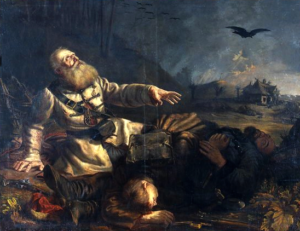
Three Generations. Painting by Antoni Kozakiewicz from 1864. The collection of the Museum of Independence. Source: Wikimedia Commons
Grzegorz Zackiewicz
The first mass exiles after the fall of the Bar Confederation and the Kościuszko Uprising mark the beginning of the Polish perception of Siberia as a “big prison without a roof”. As time went by, the concepts of Siberia as a geographical region and Sybir as a land of exile started to blur. The Siberian myth was forming under the influence of a few factors: traumas caused by Russian repressions, a profound lack of knowledge about Siberia, and the romantic, messianic vision of the Polish nation. A myth created this way combined two strands: martyrological and heroic. The exiles were presented as victims of Russian repressions – working in shackles, fighting adversities, but at the same time not renouncing their homeland and faith.
The reality was slightly different. Only a small group of exiles was sentenced to forced labour. Poles often worked as teachers, doctors or office workers. Many of them started to explore Siberia as scientists. We should not forget about settlers who went there voluntarily in search of a better life.
The lasting myth of Siberia after 1918 was due to the fact that the majority of Polish public opinion was anti-Russian. Poles treated their regained independence as confirmation that the previous fight with the perennial enemy from the East and long suffering connected with it had finally paid off. In Poland, common perceptions about the exiles to Siberia are still far from the historical realities.
Grzegorz Zackiewicz is a historian, professor at University in Bialystok
Read the text in Polish here: https://swiatsybiru.pl/pl/polski-mit-sybiru-2/



